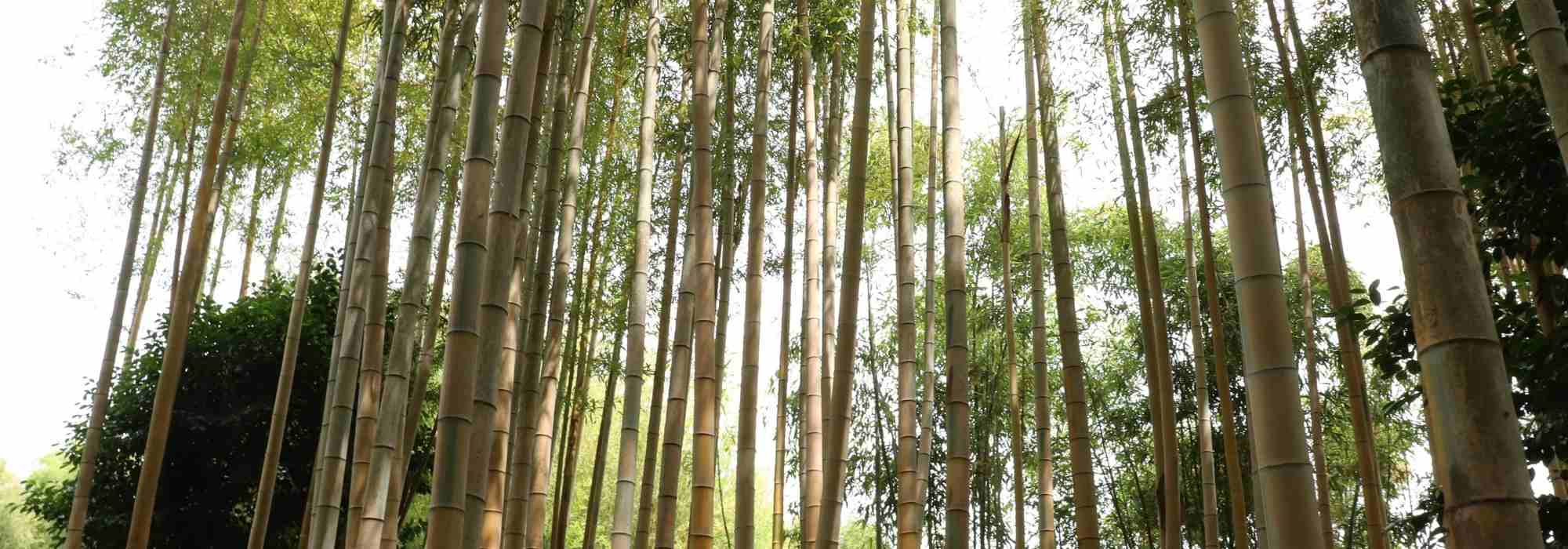
Phyllostachys: planting, growing
Contents
Phyllostachys in a nutshell
- Phyllostachys bamboos are running bamboos known for their rapid growth
- They require the installation of a rootstock barrier to control their invasive character
- They are among the tallest bamboos!
- They feature remarkable coloured canes that can reach up to 15 m in height
- Very cold-resistant, they make a good evergreen plant screen
A word from our expert
Phyllostachys are running bamboos renowned for their often explosive growth, impressive height, and… their invasive nature! Towering, they can reach up to 8 metres high for the Phyllostachys bissetii, and even 15 m for the giant Phyllostachys vivax ‘Aureocaulis’. We particularly appreciate the Phyllostachys aurea and nigra, which produce stunning golden-yellow and black culms, respectively.
This type of bamboo is ideal for quickly creating a bamboo forest or an effective privacy screen with an exotic appearance!
Perfectly hardy, Phyllostachys can withstand temperatures as low as -20°C. Easy to grow, they should be planted in cool soil, in full sun, and in a sheltered position from strong winds. You will simply need to provide them with space and contain their spread by installing a rhizome barrier. All these bamboos can be easily planted in large gardens, but also, sometimes in large containers, on terraces, and even on balconies.
Discover our superb selection of running bamboos!
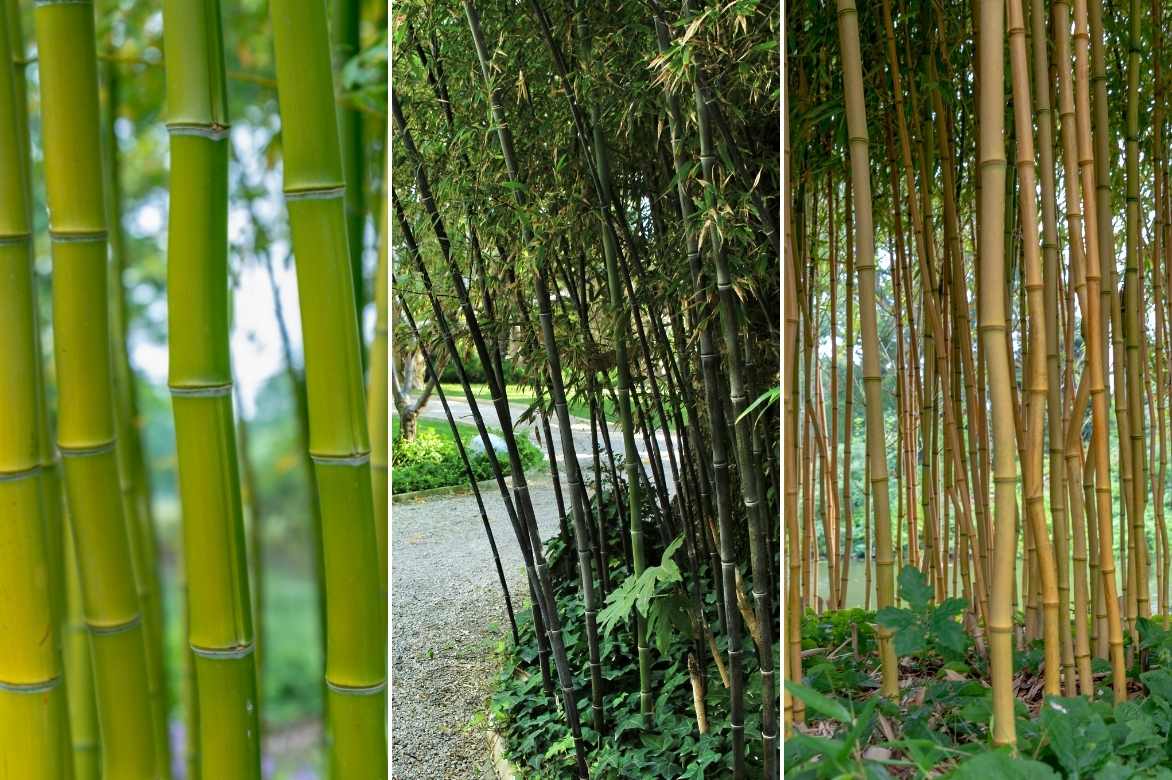
Phyllostachus aerosulcata spectabilis, Phyllostachis nigra, and Phyllostachys aerocaulis
Description and botany
Botanical data
- Latin name Phyllostachys
- Family Poaceae
- Common name Phyllostachys
- Flowering very rare and insignificant
- Height 2 to 15 m and +
- Exposure sun, partial shade
- Soil type light, cool, well-drained
- Hardiness below -15°C
The Phyllostachys bamboos are classified as running bamboos, known for their rapid growth and invasive character that is difficult to contain. Like the non-running bamboos, referred to as “cespitose”, they belong to the Poaceae family, which means grasses. They are a type of giant grass with woody stems, primarily native to China.
The genus Phyllostachys comprises around 80 species, including some of the largest that can be cultivated in temperate climates; the Phyllostachys bissetii, very vigorous and hardy, the Phyllostachys aurea, also known as golden bamboo, the Phyllostachys nigra or black bamboo, which is the only one in the genus to produce culms of ebony black colour, the Phyllostachys bambusoides, a giant bamboo, the Phyllostachys vivax, another exceptional giant bamboo very resistant to cold, the Phyllostachys humilis, one of the smallest bamboos in the Phyllostachys genus, or even the Phyllostachys aureosulcata which develops zigzag-shaped canes at their bases.
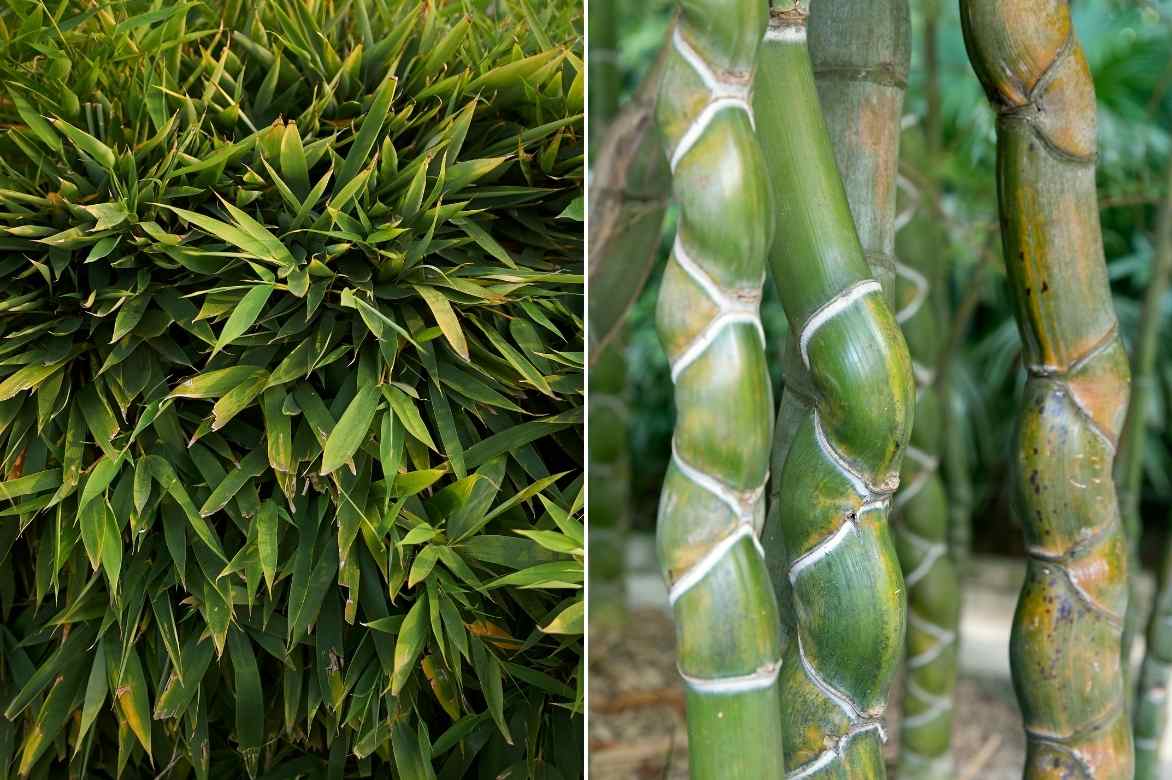
Foliage of Phyllostachys aurea and canes of Phyllostachys heterocycla
Phyllostachys are large bamboos that multiply rapidly thanks to their running rhizomes. They are woody perennial plants. Unlike other bamboos, they are known to be very invasive and require the installation of anti-rhizome barriers to contain their spread. They quickly form an inextricable network of underground rhizomes that multiply, giving rise to new shoots or turions.
They rapidly form dense and slender clumps. They produce straight and sturdy canes that can reach heights of 4 to over 15 m depending on the species and growing conditions, rarely exceeding 6 to 12 m in our climates, while they can grow up to 30 m in their native regions. Giant varieties reaching over 10 m in height will only reach full development in 7 to 10 years. Their growth is rapid, sometimes even explosive. Some Phyllostachys, such as Phyllostachys vivax, can grow several centimetres per day, with others reaching up to 1 m!
These culms or canes vary in thickness, ranging from 2 to 10 cm in diameter. Each culm is channelled. The Phyllostachys are characterised by the presence of a furrow on the internodes of their culms. There are multiple varieties with different ornamental culms. While most are straight and upright, the culms of Phyllostachys aureosulcata display a zigzag shape at their bases. Young canes are sometimes covered with a white bloom that disappears quickly, and very often, cauline sheaths eventually fall off. The colour of the canes varies from green to golden yellow to black. In some, the internodes take on a striated appearance and are adorned with subtle stripes along their entire length. Over time, the colour may change if the culms are exposed to sunlight.
The branched culms, often from the base, divide into slender branches bearing leaves. This species is distinguished from other bamboos by the presence of branches of unequal size, grouped in pairs (sometimes with a third smaller one) at each node. The Phyllostachys have beautiful, very dense foliage, perfect for forming lush hedges. The foliage, evergreen, consists of narrow, lanceolate leaves, tapering at their tips. They are glossy, dark green to light green, sometimes slightly variegated with cream, about 20 cm long, and are grouped in dense tufts along the canes. They have a lighter underside.
The flowering of bamboos is rare and insignificant, occurring only after decades of cultivation, in the form of small spikes reminiscent of those of grasses, and generally signifies the death of the plant.
The turions of all Phyllostachys species are edible when steamed or boiled. The culm of the Phyllostachys is traditionally used in Chinese medicine, particularly for remineralising the body.
Read also
Bamboo, Fargesia: planting and careMain species
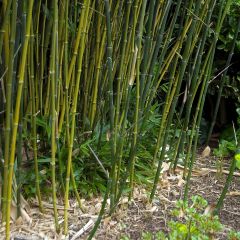
Phyllostachys bissetii - Bamboo
- Height at maturity 6 m
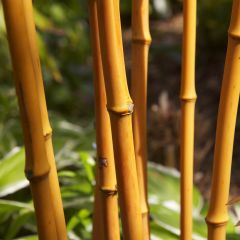
Golden Bamboo - Phyllostachys aurea
- Height at maturity 6 m
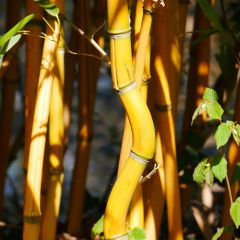
Yellow Bamboo - Phyllostachys aureosulcata Aureocaulis
- Height at maturity 6 m
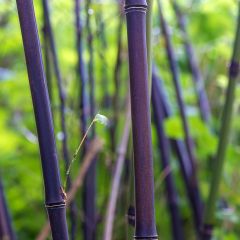
Black bamboo - Phyllostachys nigra
- Height at maturity 6 m
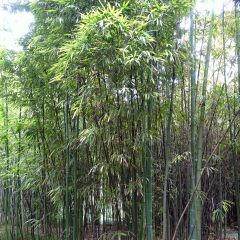
Phyllostachys iridescens - Bamboo
- Height at maturity 10 m
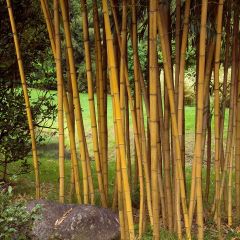
Phyllostachys vivax Aureocaulis - Golden Chinese Timber Bamboo
- Height at maturity 12 m
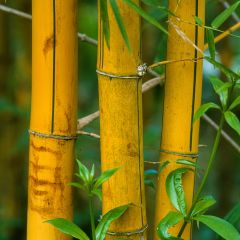
Phyllostachys viridis Sulphurea - Golden Chinese Bamboo
- Height at maturity 9 m
Discover other Phyllostachys
View all →Available in 3 sizes
Available in 3 sizes
Available in 1 sizes
Available in 2 sizes
Available in 1 sizes
Available in 2 sizes
Available in 2 sizes
Available in 2 sizes
Available in 2 sizes
Available in 1 sizes
Planting Phyllostachys
Where to plant them?
Phyllostachys are cultivated like all other bamboos. Perfectly hardy, they withstand temperatures down to –24 °C. Unfussy, they thrive in full sun or partial shade, sheltered from cold, drying winds, in any garden soil. They will tolerate full sun quite well as long as moisture is not lacking. They will quickly colonise any moist, acidic or neutral soil, provided it is rich, light, cool, free from excess lime, and well-drained. They do not fare well in waterlogged soils, especially in winter.
Running bamboos are imposing and can quickly take over. They have the drawback of their quality: in suitable soil, they spread at lightning speed and become very invasive. They require the installation of a rootstock barrier (a thick, durable polypropylene film). So think carefully about the space you can allocate to them and plan for a location that suits their needs!
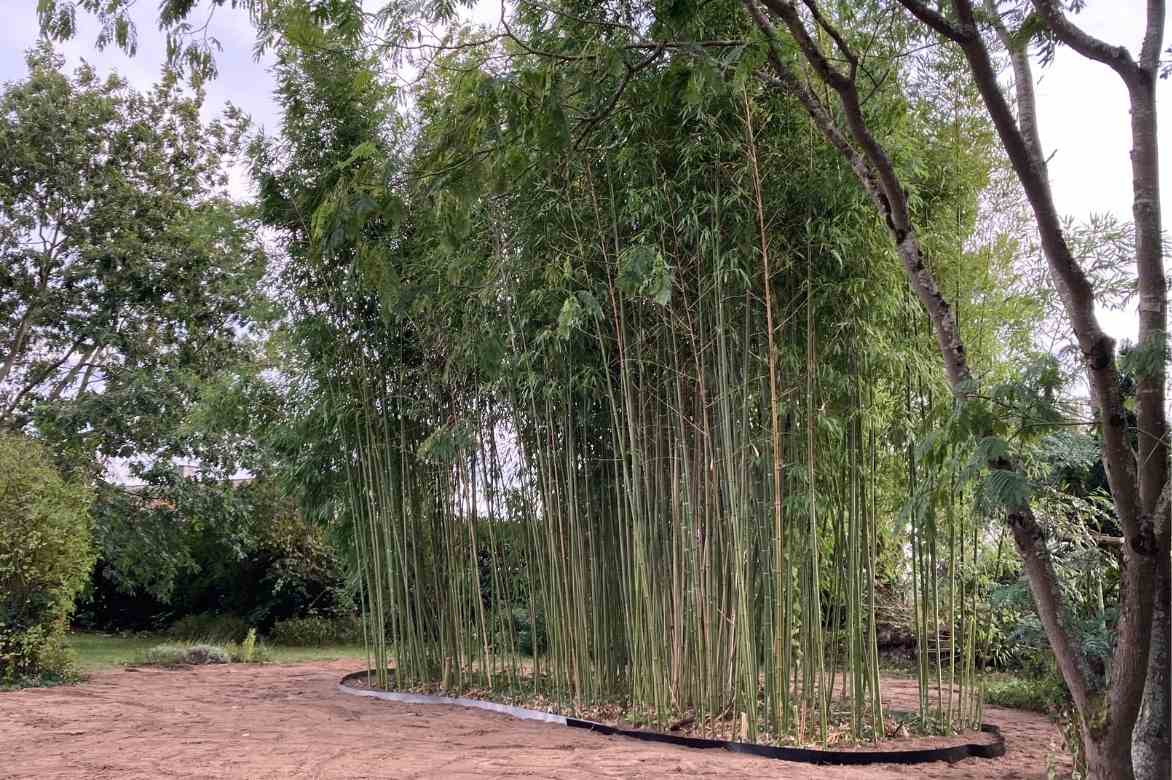
Phyllostachys surrounded by a rootstock barrier (© Gwenaëlle David Authier)
⇒ Check our article to learn how to install a rootstock barrier.
Giants like Phyllostachys bambusoides allow for the rapid creation of spectacular garden forests. Their evergreen foliage throughout the year also enables the quick formation of windbreaks or privacy screens. They are excellent plants for managing unwanted views in closely spaced areas.
They can also be planted as isolated clumps, in groves, or as free hedges. They are also perfect near water features where they seek out moisture.
The smaller specimens will find a place in pots on the terrace, adding a modern touch.
When to plant Phyllostachys?
Planting should be done in spring, from March to June after the last frosts, or preferably in early autumn, between September and November after the heat of summer. Bamboos will establish better in well-warmed soil when rainfall becomes more frequent.
How to plant them?
In open ground, maintain a planting distance of at least 1 metre between two plants.
- Weed and thoroughly loosen the soil
- Dig a trench or a wide, deep hole
- Install the rootstock barrier vertically around the plant, allowing it to extend 2-3 cm above the surface
- Place the root ball in the centre of the hole, ensuring the collar is level with the soil surface
- Spread a 5 cm layer of gravel to aid drainage
- Fill in with the excavated garden soil mixed with turf and sand
- Optionally add an organic amendment (roasted horn or dried blood). Water thoroughly at planting and mulch the base to retain some moisture
In pots
Growing in large containers allows for control over the expansion of this type of running bamboo! Be sure to monitor watering closely, as the substrate dries out more quickly in pots. Your bamboos must never lack water.
Given the growth of these large bamboos, choose a pot that is at least 50 cm in diameter and sufficiently tall, as wind resistance is significant: the pot should be heavy enough to prevent tipping. Opt for less vigorous varieties, as they may risk breaking the pot.
- Spread a layer of clay balls at the bottom of the drainage hole (¼ of the height of the container)
- Fill with a rich, light substrate made of planting compost or rose soil mixed with sand
- Water, then monitor watering closely to ensure it is very regular
- Place the pot in non-burning sunlight and sheltered from drafts
Read also
Install a rootstock barrierCare, pruning and maintenance of phyllostachys
In open ground
During the growing season, water regularly and generously: at least once a week in summer. In case of drought, mist the foliage in the evening or morning to prevent drying out.
To establish well, during the first two years after planting, young bamboos need regular watering. Generally, bamboos are sensitive to drought. They are water-hungry. Water even in winter if the soil is frozen, as frost can prevent your bamboos from accessing water in the soil.
Mulch the young stumps. Over time, the dried leaves that fall to the ground will form a natural mulch.
Apply nitrogen fertiliser in February-March, then in July-August.
In winter, remove the snow that accumulates on the culms, which may break under its weight.
Every year, at the end of winter, remove the dry canes by cutting them at the base.
⇒ To learn everything about the maintenance and pruning of your bamboos, check our sheet “Maintenance, Pruning and Care of Bamboo”
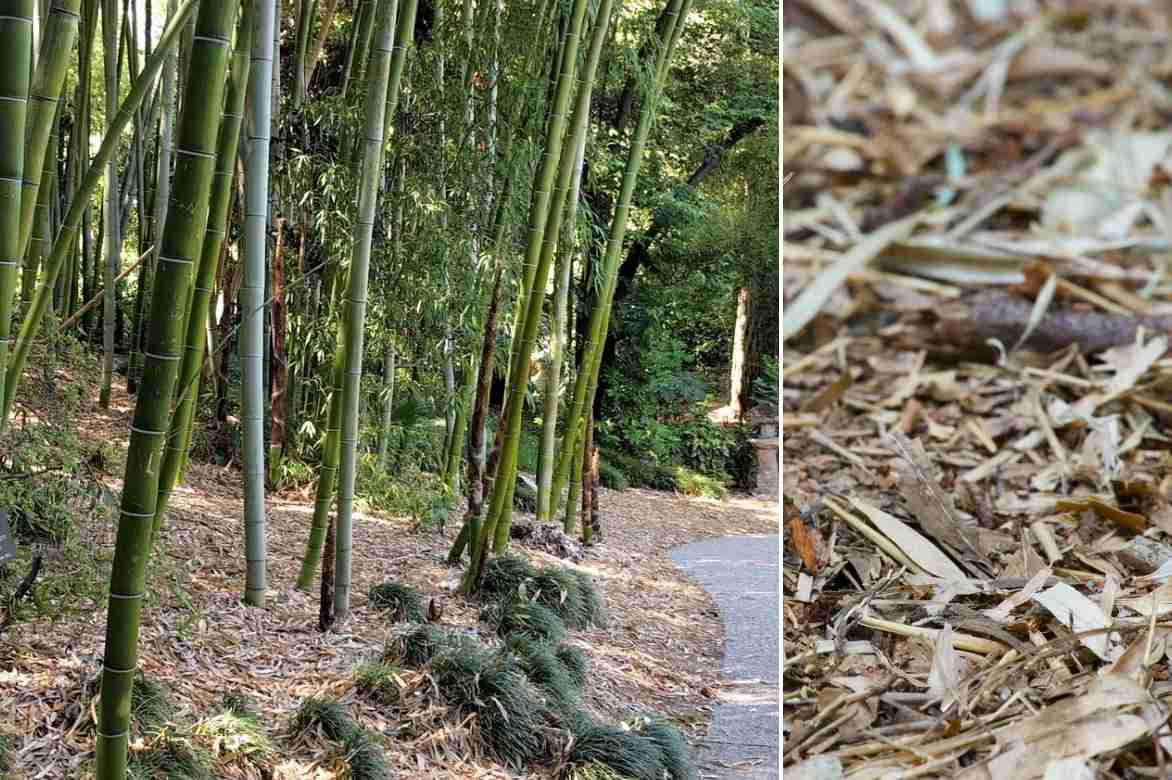
Fallen leaves of Phyllostachys forming a thick mulch (© Cultivar 413)
In pots
In pots, water frequently (up to 5 litres of water per day) in summer without allowing the soil to dry out between waterings. Fertilise monthly from April to August to encourage growth. In winter, reduce water supply. Protect the pot from cold, dry winds in winter. Repot every 2 or 3 years depending on growth.
Diseases and potential pests
Phyllostachys are not very susceptible to diseases. In spring, protect the young shoots from the appetite of slugs and snails. Here are our natural tips!
Bamboos grown in pots are sometimes attacked by mealybugs. Spraying with vegetable oil mixed with 90° alcohol and black soap can help suffocate them.
Multiplication
With a running character, phyllostachys propagate quickly, making it easy to utilise this natural tendency to acquire new young plants of bamboo. In spring, you can select clumps that are at least three years old to divide. You will obtain new culms that are smaller in size and section. They will grow larger in a few years.
- Using a spade, dig up a portion of the clump containing several culms
- Shorten the existing culms by one-third of their length
- Keep the leaves at the base
- Replant immediately in the garden or in a container
- Water generously and keep the soil moist to encourage recovery
Associating
Bamboos of the Phyllostachys genus are suitable for a variety of garden styles, from the most contemporary to the most exotic or Asian, including natural gardens and water gardens.
While giant bamboos can sometimes be challenging to integrate due to their imposing presence and often stand alone, other species of Phyllostachys lend themselves to numerous combinations.
In a water garden with cool soil, they pair well with other robust plants such as Gunnera manicata, astilbes, carex, bulrushes, beard grasses, Hakonechloa, and Hosta Big Daddy.
In a lush and exotic bed, surround them with exuberant and brightly coloured perennials like cannas and large dahlias that will complement their foliage.
They naturally associate with other Asian plants, such as Japanese grasses and Chinese palms.
To add volume, lightness, and verticality to a shrub bed, you can plant more compact plants at their base, such as hydrangeas (Annabelle, Strawberry Melba, H. quercifolia).
In a contemporary garden, plant alongside them large ornamental grasses like pennisetums, deschampsias, or miscanthus.
Finally, if you’re lacking inspiration, know that bamboos also pair very well with each other: choose varieties with differently coloured canes, and you’ll create an intensely exotic tableau!
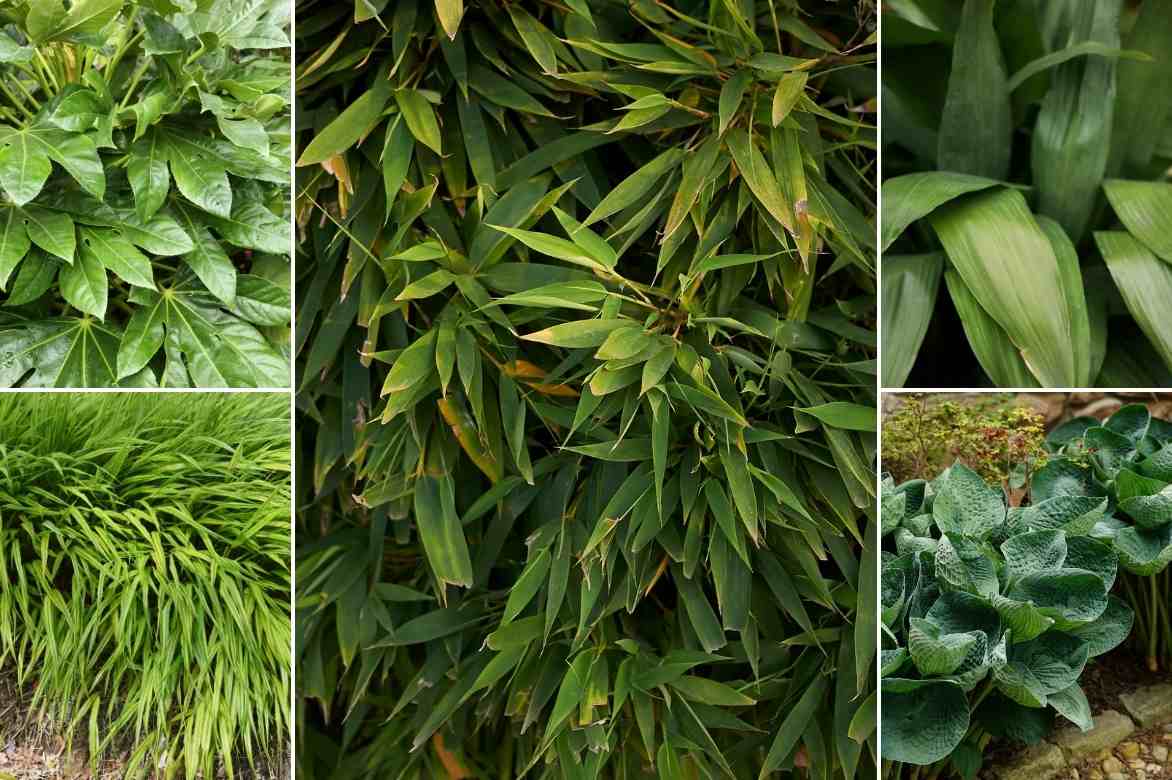
An exotic association of Phyllostachys aurea with Fatsias, Hakonechloa macra, Aspidistras, and Hostas ‘Big Daddy’
Useful resources
- Discover our wide range of bamboos!
- For everything you need to know about bamboos: visit our blog!
- The Bamboo Grove of Anduze: a paradise to discover!
- Article: Bamboo hedge, which varieties to choose?
- Discover 6 bamboos with coloured culms
- Article: 6 running bamboos
- Article: giant bamboos
- The mystery of the flowering of Bamboo henon: a rare event with unexpected consequences
- Subscribe!
- Contents































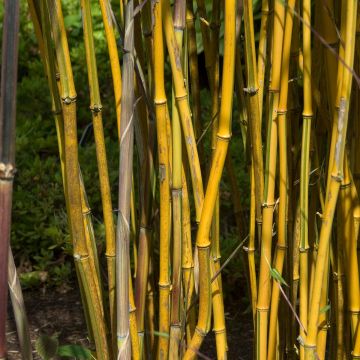
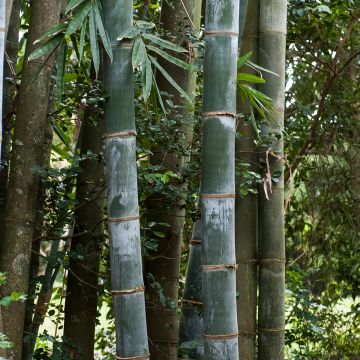

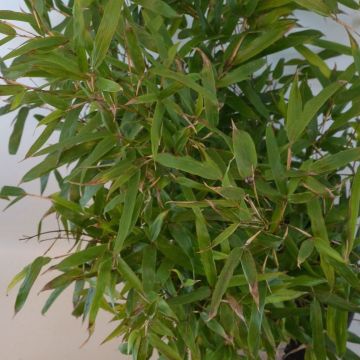
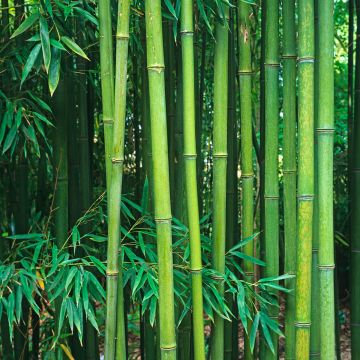
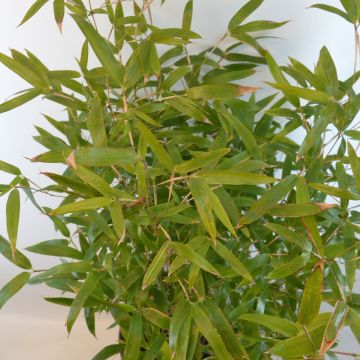
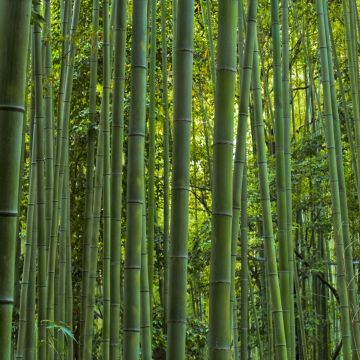
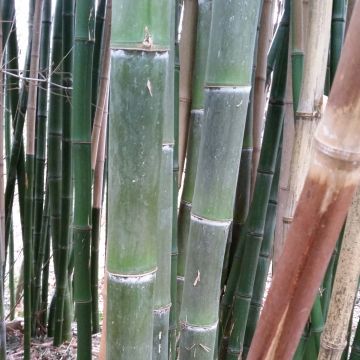

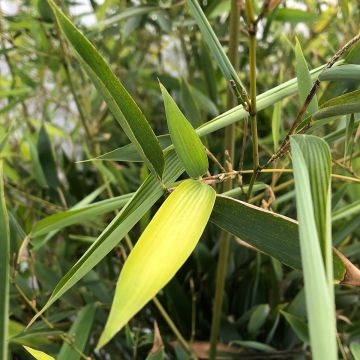
Comments